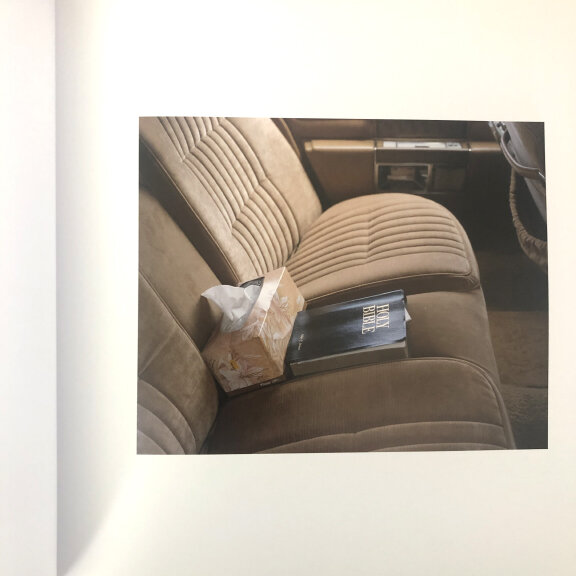As I’ve mentioned in the past on this blog, I see it as a blessing and a curse that I live within an hour’s drive of the photo bookstore Photo-Eye in Santa Fe. It is a treat to be able to peruse their excellent collection of books. They have an outstanding selection, with many rare, out-of-print volumes on the shelves, next to the latest releases. There are a number of photo books I’ve had on my “wishlist” and of course, Photo-Eye had one that I would end up taking home with me.
I was glad to find a copy of the latest release by German printer-extraordinaire Steidl, the monograph entitled “Sunshine Hotel” by photographer, Mitch Epstein. As is the case with almost all of the books printed by Gerhardt Steidl, this hardcover book is gorgeous. The image quality is first-rate, the binding is stout and immaculate, the cover an intense red and white. One of the benefits of buying from Photo-Eye as opposed to Amazon is that not only can you actually hold the book, skim through the pages and really appreciate the quality, but also they happen to carry signed copies of books. This makes the purchase extra special and obviously, extra-collectable.
For those of you unfamiliar with Mitch Epstein or his work, he is of a generation of American photographers who worked almost exclusively in color, starting in the 1970s. At the time, color photography was not taken seriously in fine art circles, and it was only through the work of Epstein, Stephen Shore, Joel Meyorwitz and of course, William Eggleston, that color photos gained wider critical acceptance. It is somewhat curious that Epstein’s work has not gotten the same kind of attention as that of Eggleston or Shore, in particular. In my opinion, it is as strong and as important as those other lauded photographers. This book might go a long way to move Epstein to the forefront in the minds of the admittedly niche audience that I happen to be part of.
There is something so “American” about this book. Starting with the title, which I interpret as a metaphor for the Unites States itself. A place of escape, a place of hope, a place to aspire to, but also a place of temporality, of false surfaces, of pain, of winning and losing at the game of capitalism, as a place of fear, of hatred, of loneliness and sadness. These photos convey every side of the “American Dream.” The lonely roads that Robert Frank explored 50 years before, now windswept and covered in blowing snow when captured by Epstein. Our great monuments to democracy, now hidden or protected behind anti-terrorism barricades. Decay, debris, remnants of brutal natural disasters, all shown in subtle, tactful framing and realistic tones. The great experiment of the American experience is seen on these pages, in all its glory and folly. Peppered throughout are images that show us not only how we used to live, but also how we live today. The fashion may change, but the looks on the faces remain the same.
The book opens and closes with photographs taken on the Standing Rock Sioux Reservation. I think this is fitting, as all the work in-between was created on land that our forefathers took from the indigenous tribes, through a variety of dubious means. Does this make “Sunshine Hotel” a political book? One may think so. In larger sense, how can any creative statement at this time not bear some subtle political stance to it? At the same time, I think of Epstein as a documentarian, first and foremost. Of course, he is also an artist, one of great depth. His images are made to ponder individually, assessing the lives of those shown, the story behind the places. But also, in a grander way, it is an exploration of what our nation looks like, reflected in the mirror that is Mitch Epstein’s camera. I highly recommend spending time at the Sunshine Hotel, where you can check out any time you like, but you can never leave.




